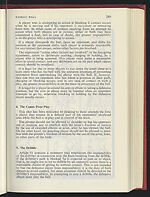1964-65
(274)
Download files
Complete book:
Individual page:
Thumbnail gallery: Grid view | List view

248
BASKET BALL
2. Basic principles governing Personal Contact
Many decisions related to personal contact must be the result of a
judgment which must be exercised with the following basic principles
in mind:
(a) It is the duty of each player to avoid contact in any possible
way;
(b)
Any player is entitled to a normal floor position not occupied
by an opponent, provided he does not cause personal contact
in taking such position;
(c) If a contact foul occurs, the foul is caused by the player re-
sponsible for the contact.
The following criteria may be used in determining responsibility
for personal contact:
If a player B takes a position
(a) behind and so close to a stationary opponent A, that a contact
foul occurs when A makes normal body movements, then B is
primarily responsible for the foul, or
(b)
at the side or in front of a stationary opponent A, without
contact, then A is primarily responsible for any contact foul
caused by A's subsequent movements, or
(c) in the path of a moving opponent A, who does not have the
ball, so quickly that A cannot stop or change direction in time
to avoid contact, then B is primarily responsible if contact
occurs.
In case of doubt the greater responsibility is on B.
If a player B establishes a legal guarding position in the path of a
dribbler A, and a contact foul occurs, A has the greater responsibility.
If a player B tries to reach the ball from a position at the rear or side
of A, when the latter is in control of it, or if B attempts to reach an
uncontrolled ball when A is in a more favourable position, then B
has the greater responsibility if a contact foul occurs.
3. Blocking
A player is entitled to take any position on the court not occupied
by another player, provided that:
(a) this position is not so close to an opponent (less than approxi-
mately 3 ft.) that contact ensues when the opponent makes
normal bodily movements, or
(b)
this position is not taken in the path of a moving opponent so
quickly that the latter cannot avoid contact.
In the foregoing cases, the player who takes the position described
is responsible if contact ensues, unless other factors are involved.
BASKET BALL
2. Basic principles governing Personal Contact
Many decisions related to personal contact must be the result of a
judgment which must be exercised with the following basic principles
in mind:
(a) It is the duty of each player to avoid contact in any possible
way;
(b)
Any player is entitled to a normal floor position not occupied
by an opponent, provided he does not cause personal contact
in taking such position;
(c) If a contact foul occurs, the foul is caused by the player re-
sponsible for the contact.
The following criteria may be used in determining responsibility
for personal contact:
If a player B takes a position
(a) behind and so close to a stationary opponent A, that a contact
foul occurs when A makes normal body movements, then B is
primarily responsible for the foul, or
(b)
at the side or in front of a stationary opponent A, without
contact, then A is primarily responsible for any contact foul
caused by A's subsequent movements, or
(c) in the path of a moving opponent A, who does not have the
ball, so quickly that A cannot stop or change direction in time
to avoid contact, then B is primarily responsible if contact
occurs.
In case of doubt the greater responsibility is on B.
If a player B establishes a legal guarding position in the path of a
dribbler A, and a contact foul occurs, A has the greater responsibility.
If a player B tries to reach the ball from a position at the rear or side
of A, when the latter is in control of it, or if B attempts to reach an
uncontrolled ball when A is in a more favourable position, then B
has the greater responsibility if a contact foul occurs.
3. Blocking
A player is entitled to take any position on the court not occupied
by another player, provided that:
(a) this position is not so close to an opponent (less than approxi-
mately 3 ft.) that contact ensues when the opponent makes
normal bodily movements, or
(b)
this position is not taken in the path of a moving opponent so
quickly that the latter cannot avoid contact.
In the foregoing cases, the player who takes the position described
is responsible if contact ensues, unless other factors are involved.
Set display mode to:
![]() Universal Viewer |
Universal Viewer | ![]() Mirador |
Large image | Transcription
Mirador |
Large image | Transcription
| Games and sports in the army > 1964-65 > (274) |
|---|
| Permanent URL | https://digital.nls.uk/249213798 |
|---|
| Description | 'Games and Sports in the Army' was an annual publication produced by the British War Office between the 1930s and 1960s. This included the Second World War. It outlines the rules and regulations for games and sports played by members of the armed forces. It features names and photographs of team members, and examples of contemporary advertising. |
|---|---|
| Shelfmark | GWB.52 |

